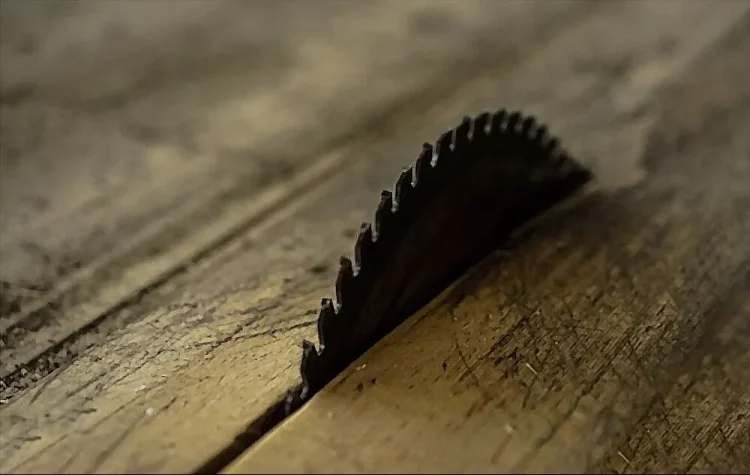A table saw is a versatile and powerful tool that is commonly used in woodworking and construction. It is designed to make precise cuts in wood, plastic, and other materials using a circular saw blade that is mounted on an arbor. The blade is driven by an electric motor and is raised and lowered using a hand crank or electronic controls.
The material to be cut is placed on a table, which provides a stable surface for cutting and allows for accurate adjustments to the cut depth and angle. Table saws can be used for a variety of tasks, including ripping, cross-cutting, bevel cutting, and more. They are an essential tool for any woodworking shop, construction site, or DIY enthusiast.
Uses of a Table Saw
Here are the most common tasks in which you may have to depend upon a table saw:
Ripping Wood
Ripping refers to cutting a piece of wood along its length, also known as a “rip cut.”
On a table saw, ripping is done by adjusting the saw blade to the desired width of the cut and adjusting the fence (a guide that runs parallel to the saw blade) to the correct distance from the blade. The piece of wood is then pushed through the saw blade, using the fence as a guide to ensure a straight and accurate cut.
Ripping is often used to reduce the width of a piece of wood, such as when making a table top from a wide board. It can also be used to create a specific width of board from an existing piece of wood. Ripping is also used to cut along the grain of the wood, which will result in a more stable piece of wood than cross cutting.
It’s important to note that when ripping on a table saw, the piece of wood should be secured with a push stick or miter gauge, and the operator should use a suitable guard and blade cover to avoid injury.
Kerf Cuts
A table saw is commonly used to make kerf cuts by adjusting the width of the saw blade to match the desired width of the cut. The material is then pushed through the blade, creating a precise cut of the desired width. Kerf cuts can be used for a variety of purposes, such as creating grooves for joints in woodworking or cutting material to a specific size. Additionally, Kerf cuts is also used in creating bevels and angled cuts.
Cross-Cut
A table saw is typically used for cross-cutting by adjusting the angle of the blade to 90 degrees and using the miter gauge to guide the wood through the blade, resulting in a perpendicular cut. The wood is placed against the miter gauge and pushed through the blade, resulting in a clean and precise cut.
When using a table saw for cross-cutting, the first step is to adjust the angle of the blade to 90 degrees. This ensures that the blade is perpendicular to the table and will make a clean, straight cut across the wood.
Next, the miter gauge is used to guide the wood through the blade. The miter gauge is a tool that attaches to the table saw and allows for precise control of the angle and position of the wood as it is pushed through the blade. The wood is placed against the miter gauge and pushed through the blade, resulting in a clean and precise cut.
Also Learn About: Different Parts of a Table Saw
Another way to make accurate cross-cuts with a table saw is to use a cross-cut sled. This is a specialized jig that attaches to the table saw and allows for precise control of the angle and position of the wood as it is pushed through the blade. The cross-cut sled can be adjusted to make precise cuts at any angle, and it also provides support for the wood while it is being cut, which helps to prevent kickback and other hazards.
It is important to note that when making cross-cuts, the wood should be securely clamped in place or held firmly against the miter gauge or cross-cut sled to prevent movement and ensure a clean, precise cut. Always use appropriate safety gear, such as eye and ear protection and ensure the saw is properly adjusted, before using a table saw.
Bevel Cuts
A bevel cut on a table saw is when the blade is tilted at an angle, rather than being perpendicular to the table. This allows for angled cuts to be made on the wood. Bevel cuts are often used for creating joints, such as a 45 degree angle for a miter joint.
To make a bevel cut on a table saw, the user first needs to adjust the blade to the desired angle. This is typically done by using a bevel adjustment knob or lever, which is located on the side of the saw’s elevation mechanism. Once the angle is set, the wood is placed against the fence and pushed through the blade.
It’s important to note that the bevel angle can be adjusted on both left and right side of the saw’s table, which allows for more flexibility in the cuts you can make. Additionally, Some table saws have a built-in scale that shows the angle of the blade, while others require the user to use a protractor to set the angle.

Miter Cuts
A miter cut is a type of angled cut that is made on a table saw. It is used to join two pieces of wood at an angle, such as when creating a corner joint or a picture frame.
To make a miter cut on a table saw, the wood is placed against the saw’s fence at the desired angle and the saw’s blade is lowered to make the cut.
The angle of the cut is usually adjusted using the saw’s miter gauge or a specialized miter sled. It’s important to use the proper safety equipment and techniques when making miter cuts on a table saw.
Dado Cuts
a table saw can be used for making dado cuts. A dado cut is a type of cut that is made across the grain of the wood, typically used for making grooves for joints such as for shelves in a bookcase.
To make a dado cut on a table saw, a special type of blade called a dado blade set is used. The dado blade set is a group of blades that are mounted together on the arbor of the table saw. The blades in the set are adjustable, so the width of the dado cut can be adjusted by moving the blades closer together or further apart.
The wood is then placed against the fence, and the blade is lowered to make the cut. The dado blade set makes multiple cuts at once, which creates the groove. It is important to make sure that the wood is securely clamped to the table saw and that the blade is properly adjusted before making the cut to ensure safety and accuracy.
Rabbets & Grooves
A table saw is used to deal with rabbets and grooves in a woodworking project. A rabbet is a rectangular groove cut into the edge of a board, while a groove is a similar cut made along the length of the board.
These joints allow two pieces of wood to fit together snugly and securely, creating a stronger overall structure. They are often used in cabinet and furniture making, as well as for building walls and flooring. To make these cuts, a table saw is equipped with a dado blade, which is a type of saw blade that can make wide cuts.
This blade is adjusted to the desired width of the cut, and the wood is then passed through the saw, creating the rabbet or groove.
Conclusion
In conclusion, a table saw is a versatile and powerful tool that can be used for a variety of woodworking tasks, including ripping, cross-cutting, and making angled cuts. It is an essential tool for any woodworker, whether a professional or a hobbyist. With the right blade and proper safety precautions, a table saw can make precise cuts with ease, saving time and effort. Whether you are building a new piece of furniture or working on a remodel project, a table saw is a valuable tool to have in your workshop.

Meet Max, the founder and lead writer of our home improvement blog. He is a seasoned home renovation and design expert with over 8 years of experience in the industry.
Max has a passion for creating beautiful and functional living spaces and is dedicated to helping homeowners and DIY enthusiasts achieve their home improvement goals. He has worked on a wide range of projects, from small updates to full-scale renovations, and has a wealth of knowledge and experience to share.
As an avid DIYer, Max understands the challenges and rewards of tackling a home improvement project and enjoys sharing his tips, tricks and insights to make the process as easy and enjoyable as possible. In his free time, Max can be found working on his own home renovation projects, reading design blogs and magazines, and travelling to explore new design trends.
Max is excited to share his knowledge and experience with you and hopes to inspire and empower you to take on your next home improvement project with confidence. Follow Max on LinkedIn for more inspiration and expert advice.


